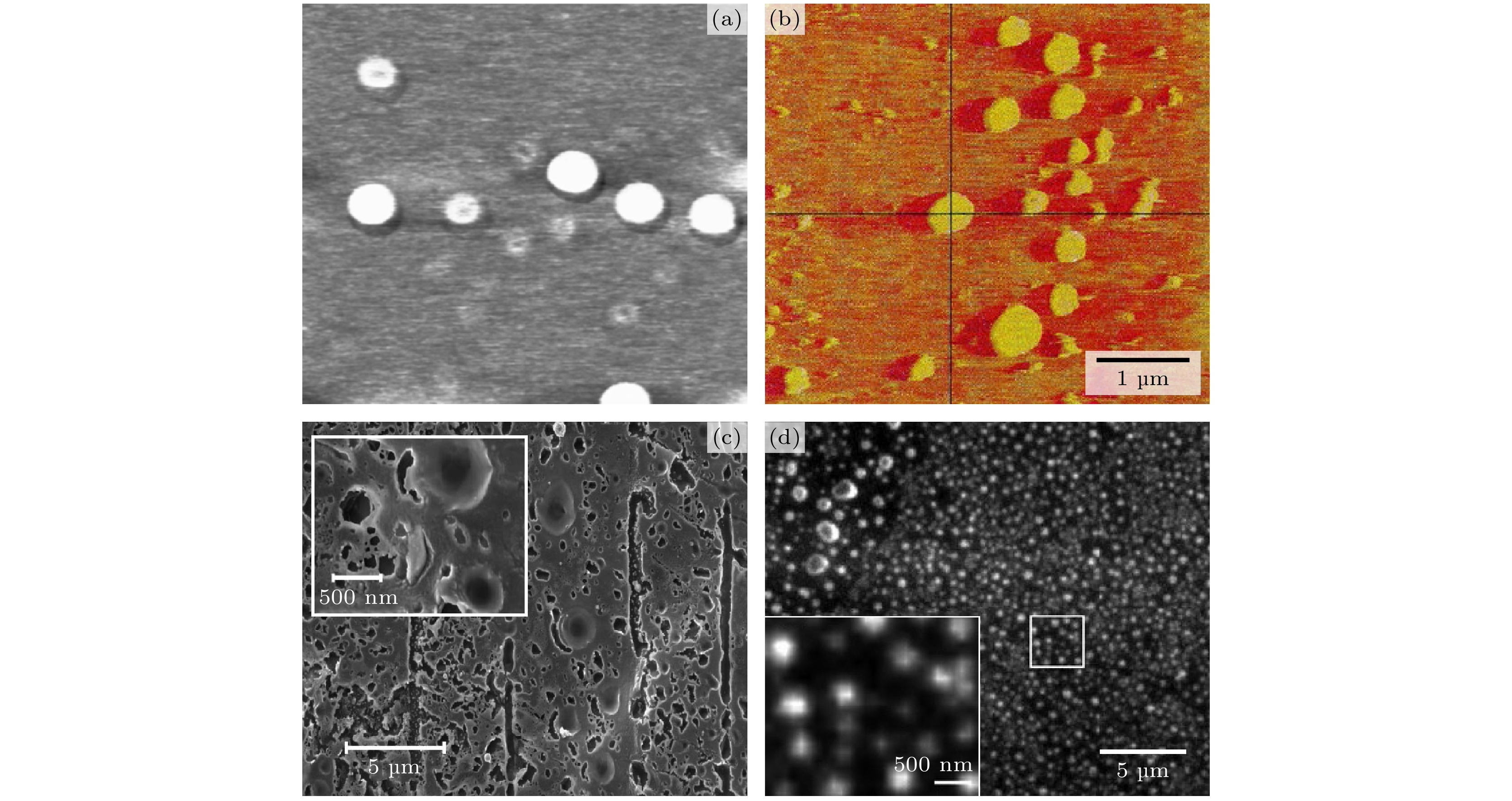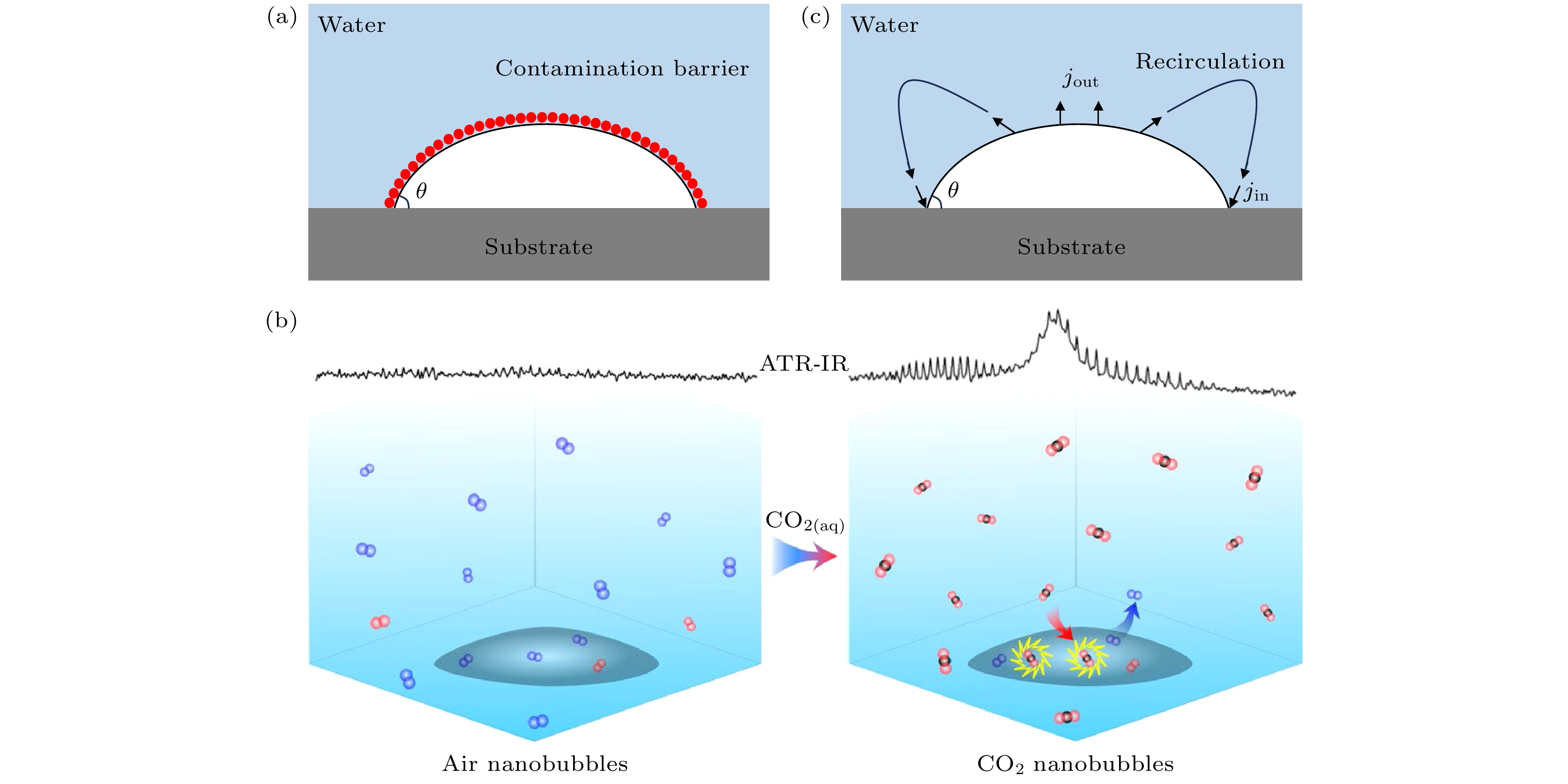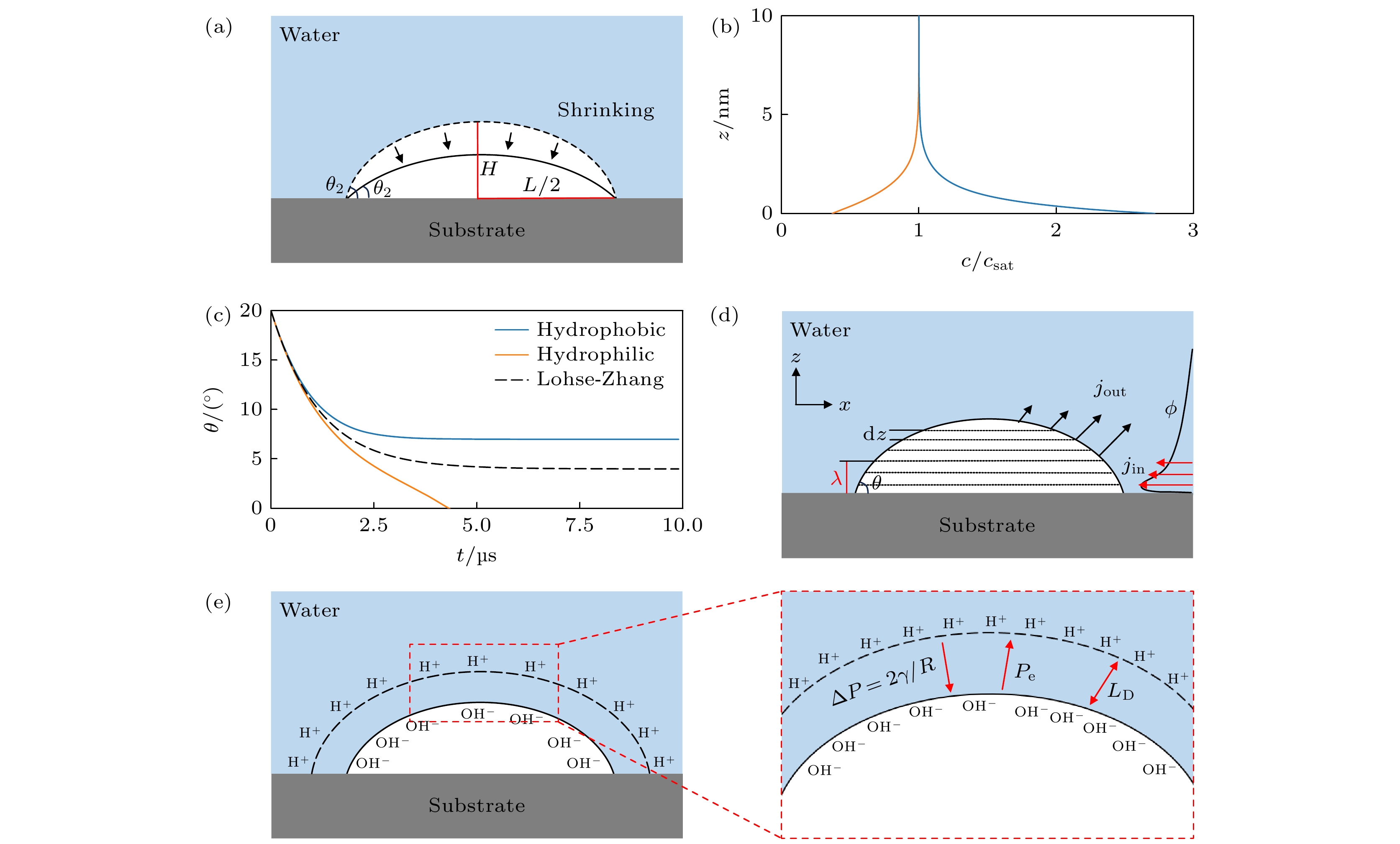-
表面纳米气泡作为固液界面上形成的纳米级气体域, 凭借其纳米级尺寸、快速动态响应特性及良好的生物相容性, 在超声成像及抗菌消毒等生物医学领域展现出重要应用价值. 在生物医学实际应用场景中, 表面纳米气泡的稳定性直接关乎其功能发挥的效率与生物安全性. 然而, 表面纳米气泡的稳定性与经典热力学理论预测的微秒级时间内溶解存在显著矛盾, 对稳定性理论模型的构建提出了迫切需求. 现有理论模型虽从不同角度阐释表面纳米气泡的稳定性机制, 但缺乏内在关联且存在各种局限性, 制约了以稳定性为导向的表面纳米气泡定向优化. 本文系统梳理了表面纳米气泡稳定性机制的研究进展, 首先回顾了表面纳米气泡的发现历程; 接着, 讨论了污染屏障模型、动态平衡模型、接触线钉扎模型、局部过饱和模型、界面电荷富集模型以及内部高密度模型等多种理论模型的内在关联与局限性; 最后, 探讨了表面纳米气泡在生物医学领域的具体应用与面临的挑战, 并基于其稳定性理论模型提出可能优化策略与展望.Surface nanobubbles, as nanoscale gaseous domains spontaneously formed at solid-liquid interfaces, exhibit significant potential applications in the biomedical field due to their unique nanoscale size effects, rapid dynamic response characteristics, and favorable biocompatibility. In ultrasonic imaging, surface nanobubbles enhance tissue acoustic contrast by generating strong harmonic scattering signals through nonlinear oscillation under stable cavitation. In antibacterial disinfection applications, the rupture of surface nanobubbles generates a transient high pressure, which synergizes with oxidative damage mediated by reactive oxygen species /hydroxyl radicals to achieve efficient bacterial inactivation. However, in physiological environments, blood flow shear stress and pH fluctuations may induce premature rupture of surface nanobubbles, leading to imaging signal attenuation or risks of non-specific tissue damage, rendering their stability a critical factor determining functional efficacy and biosafety. Notably, the experimental observation of surface nanobubble lifetimes (ranging from hours to days) significantly contradicts the dissolution behavior within microseconds predicted by classical thermodynamic theory, which urgently demands the construction of theoretical models of stability. Although existing theoretical modelshave elucidated the stability mechanisms of surface nanobubbles from multiple perspectives, they arelimited by the lack of intrinsic correlation and inherent limitations, thereby restricting targeted optimization of stability: the contamination barrier model emphasizes that surfactant adsorption inhibits gas diffusion; the dynamic equilibrium model explains that stability arises from the dynamic balance of gas exchange at the gas-liquid interface; the contact line pinning model reveals that substrate heterogeneity constrains the evolution of the three-phase contact line; the local supersaturation model proposes that local high-concentration gas layers formed by substrate adsorption delay dissolution; the interfacial charge enrichment model suggests that electrostatic pressure from the double layer counteracts the Laplace pressure driving dissolution; the internal high-density model assumes that the condensed high-density gas inside reduces diffusion rate and partially counteracts the Laplace pressure. This review systematically summarizes the research progress of the stability mechanisms of surface nanobubbles. It first reviews the discovery history of surface nanobubbles, then deeply analyzes the core mechanisms, intrinsic correlations, and limitations of the aforementioned theoretical models., Finally, it examines the technical challenges faced by surface nanobubbles with the application examples in the biomedical field, and proposes potential optimization strategies and future perspectives based on ther theoretical models of stability.
-
Keywords:
- surface nanobubbles /
- stability /
- theoretical models
[1] Lentacker I, De Cock I, Deckers R, De Smedt S C, Moonen C T W 2014 Adv. Drug Delivery Rev. 72 49
 Google Scholar
Google Scholar
[2] Zhou X Y, Guo L, Shi D D, Duan S J, Li J 2019 Nanoscale Res. Lett. 14 24
 Google Scholar
Google Scholar
[3] Yang H L, Cai W B, Xu L, Lü X H, Qiao Y B, Li P, Wu H, Yang Y L, Zhang L, Duan Y Y 2015 Biomaterials 37 279
 Google Scholar
Google Scholar
[4] Rafeeq S, Ovissipour R 2021 Foods 10 2154
 Google Scholar
Google Scholar
[5] Epstein P S, Plesset M S 1950 J. Chem. Phys. 18 1505
 Google Scholar
Google Scholar
[6] Ljunggren S, Eriksson J C 1997 Colloids Surf. A 129 151
 Google Scholar
Google Scholar
[7] Yang J W, Duan J M, Fornasiero D, Ralston J 2003 J. Phys. Chem. B 107 6139
 Google Scholar
Google Scholar
[8] Zhang X H, Quinn A, Ducker W A 2008 Langmuir 24 4756
 Google Scholar
Google Scholar
[9] Batchelor D V, Armistead F J, Ingram N, Peyman S A, McLaughlan J R, Coletta P L, Evans S D 2022 Langmuir 38 13943
 Google Scholar
Google Scholar
[10] Ducker W A 2009 Langmuir 25 8907
 Google Scholar
Google Scholar
[11] Brenner M P, Lohse D 2008 Phys. Rev. Lett. 101 214505
 Google Scholar
Google Scholar
[12] Zhang X H, Chan D Y, Wang D Y, Maeda N 2013 Langmuir 29 1017
 Google Scholar
Google Scholar
[13] Tan B H, An H J, Ohl C D 2018 Phys. Rev. Lett. 120 164502
 Google Scholar
Google Scholar
[14] Chang A S, Niu B, Liu J, Han H R, Zhang Z B, Wang W 2023 Particuology 81 128
 Google Scholar
Google Scholar
[15] Zhou L M, Wang X Y, Shin H J, Wang J, Tai R Z, Zhang X H, Fang H P, Xiao W, Wang L, Wang C L 2020 J. Am. Chem. Soc. 142 5583
 Google Scholar
Google Scholar
[16] Koshiyama K, Wada S 2016 Sci. Rep. 6 28164
 Google Scholar
Google Scholar
[17] Lohse D, Zhang X H 2015 Rev. Mod. Phys. 87 981
 Google Scholar
Google Scholar
[18] Tan B H, An H J, Ohl C D 2021 Curr. Opin. Colloid Interface Sci. 53 101428
 Google Scholar
Google Scholar
[19] Sun L, Zhang F H, Guo X M, Qiao Z M, Zhu Y, Jin N, Cui Y, Yang W M 2022 Particuology 60 99
 Google Scholar
Google Scholar
[20] Parker J L, Claesson P M, Attard P 1994 J. Phys. Chem. 98 8468
 Google Scholar
Google Scholar
[21] Ishida N, Sakamoto M, Miyahara M, Higashitani K 2000 Langmuir 16 5681
 Google Scholar
Google Scholar
[22] Lou S T, Ouyang Z Q, Zhang Y, Li X J, Hu J, Li M Q, Yang F J 2000 J. Vac. Sci. Technol. B: Microelectron. Nanometer Struct Process, Meas, Phenom. 18 2573
 Google Scholar
Google Scholar
[23] Ishida N, Inoue T, Miyahara M, Higashitani K 2000 Langmuir 16 6377
 Google Scholar
Google Scholar
[24] Holmberg M, Kühle A, Garnæs J, Mørch K A, Boisen A 2003 Langmuir 19 10510
 Google Scholar
Google Scholar
[25] Motornov M, Sheparovych R, Tokarev I, Roiter Y, Minko S 2007 Langmuir 23 13
 Google Scholar
Google Scholar
[26] Shen G X, Zhang X H, Ming Y, Zhang L J, Zhang Y, Hu J 2008 J. Phys. Chem. C 112 4029
 Google Scholar
Google Scholar
[27] Ball P 2003 Nature 423 25
 Google Scholar
Google Scholar
[28] Zhang X H, Khan A, Ducker W A 2007 Phys. Rev. Lett. 98 136101
 Google Scholar
Google Scholar
[29] Zhang X H 2008 Phys. Chem. Chem. Phys. 10 6842
 Google Scholar
Google Scholar
[30] Mezger M, Reichert H, Schöder S, Okasinski J, Schröder H, Dosch H, Palms D, Ralston J, Honkimäki V 2006 Proc. Natl. Acad. Sci. 103 18401
 Google Scholar
Google Scholar
[31] Steitz R, Gutberlet T, Hauss T, Klösgen B, Krastev R, Schemmel S, Simonsen A C, Findenegg G H 2003 Langmuir 19 2409
 Google Scholar
Google Scholar
[32] Switkes M, Ruberti J W 2004 Appl. Phys. Lett. 84 4759
 Google Scholar
Google Scholar
[33] Chan C U, Ohl C D 2012 Phys. Rev. Lett. 109 174501
 Google Scholar
Google Scholar
[34] Barnes G T 1986 Adv. Colloid Interface Sci. 25 89
 Google Scholar
Google Scholar
[35] Dressaire E, Bee R, Bell D C, Lips A, Stone H A 2008 Science 320 1198
 Google Scholar
Google Scholar
[36] Zhang X H, Li G, Maeda N, Hu J 2006 Langmuir 22 9238
 Google Scholar
Google Scholar
[37] German S R, Wu X, An H J, Craig V S, Mega T L, Zhang X H 2014 ACS Nano 8 6193
 Google Scholar
Google Scholar
[38] Dietrich E, Zandvliet H J, Lohse D, Seddon J R 2013 J. Phys. : Condens. Matter 25 184009
 Google Scholar
Google Scholar
[39] Weijs J H, Lohse D 2013 Phys. Rev. Lett. 110 054501
 Google Scholar
Google Scholar
[40] Liu Y W, Wang J J, Zhang X R, Wang W C 2014 J. Chem. Phys. 140 054705
 Google Scholar
Google Scholar
[41] Liu Y W, Zhang X R 2014 J. Chem. Phys. 141 134702
 Google Scholar
Google Scholar
[42] Lohse D, Zhang X H 2015 Phys. Rev. E 91 031003
 Google Scholar
Google Scholar
[43] Chan C U, Arora M, Ohl C D 2015 Langmuir 31 7041
 Google Scholar
Google Scholar
[44] An H J, Tan B H, Zeng Q Y, Ohl C D 2016 Langmuir 32 11212
 Google Scholar
Google Scholar
[45] Wang L, Wang X Y, Wang L S, Hu J, Wang C L, Zhao B Y, Zhang X H, Tai R Z, He M D, Chen L Q 2017 Nanoscale 9 1078
 Google Scholar
Google Scholar
[46] Nag S, Tomo Y, Teshima H, Takahashi K, Kohno M 2021 Phys. Chem. Chem. Phys. 23 24652
 Google Scholar
Google Scholar
[47] Bull D S, Nelson N, Konetski D, Bowman C N, Schwartz D K, Goodwin A P 2018 J. Phys. Chem. Lett. 9 4239
 Google Scholar
Google Scholar
[48] Lan L L, Pan Y C, Zhou L M, Kuang H, Zhang L J, Wen B H 2025 J. Colloid Interface Sci. 678 322
 Google Scholar
Google Scholar
[49] Tan B H, An H J, Ohl C D 2019 Phys. Rev. Lett. 122 134502
 Google Scholar
Google Scholar
[50] Zhang H G, Guo Z J, Zhang X R 2020 Soft Matter 16 5470
 Google Scholar
Google Scholar
[51] Ma X T, Li M B, Pfeiffer P, Eisener J, Ohl C D, Sun C 2022 J. Colloid Interface Sci. 606 1380
 Google Scholar
Google Scholar
[52] Bunkin N F, Shkirin A V, Suyazov N V, Babenko V A, Sychev A A, Penkov N V, Belosludtsev K N, Gudkov S V 2016 J. Phys. Chem. B 120 1291
 Google Scholar
Google Scholar
[53] Wang C L, Li Z X, Li J Y, Xiu P, Hu J, Fang H P 2008 Chin. Phys. B 17 2646
 Google Scholar
Google Scholar
[54] Zhang L J, Chen H, Li Z X, Fang H P, Hu J 2008 Sci. China, Ser. G 51 219
 Google Scholar
Google Scholar
[55] Wang S, Zhou L M, Wang X Y, Wang C L, Dong Y M, Zhang Y, Gao Y X, Zhang L J, Hu J 2019 Langmuir 35 2498
 Google Scholar
Google Scholar
[56] Sun Z H, Gu Z H, Ma W 2023 Anal. Chem. 95 3613
 Google Scholar
Google Scholar
-
图 1 (a)表面纳米气泡和体相纳米气泡示意图; (b)两个疏水表面之间测量得到的力与距离曲线的阶梯状特征图[20]; (c)两疏水表面之间相互作用过程示意图[21]
Fig. 1. (a) Schematic illustration of surface nanobubbles and bulk nanobubbles; (b) force versus distance curve measured between two hydrophobic surfaces, exhibiting discrete stepwise features[20]; (c) schematic representation of the interaction mechanism between two hydrophobic surfaces during approach and separation[21].
图 2 (a)水中轻敲模式下云母表面纳米气泡的AFM图像, 视野尺寸为1 μm×1 μm[22]; (b)轻敲模式AFM观察到水中疏水化处理的硅片表面形成的纳米气泡[23]; (c)利用RCF技术实现在疏水基底与空气饱和水体系中纳米气泡的成像[32]; (d)利用TIRFM技术在玻璃表面上观察到的纳米气泡图像[33]
Fig. 2. (a) AFM image of bubbles on mica surface in water in tapping mode, field of view: 1 μm×1 μm[22]; (b) tapping mode AFM image of surface nanobubbles formed on a hydrophobically modified silicon wafer in water[23]; (c) nanobubble imaging on a hydrophobic substrate in an air-saturated aqueous system using RCF microscopy[32]; (d) TIRFM image of nanobubbles observed on a glass substrate[33].
图 3 (a)污染屏障模型示意图, 表面纳米气泡气-液界面被表面活性剂修饰的污染层覆盖, 阻碍了与周围环境的气体交换; (b)表面纳米气泡具有可渗透的气-液界面, 描绘了空气纳米气泡和周围的CO2饱和水之间的气体交换[37]; (c)动态平衡模型示意图, 三相接触线附近气体的流入用以抵消整个纳米气泡表面的气体流出
Fig. 3. (a) Schematic diagram of the pollution barrier model, the gas-liquid interface of surface nanobubbles is covered by a surfactant-modified contamination layer, hindering gas exchange with the surrounding environment; (b) schematic diagram of surface nanobubbles with permeable gas-liquid interfaces, depicts gas exchange between air nanobubbles and the surrounding CO2-saturated aqueous medium[37]; (c) schematic diagram of the dynamic equilibrium model, gas influx localized near the three-phase contact line counterbalances gas efflux distributed across the entire nanobubble surface, maintaining bubble stability.
图 4 (a)接触线钉扎模型示意图, 表面纳米气泡收缩时, 其横向直径L保持不变, 只改变其高度H(即接触角$\theta $); (b)气体浓度分布基底间距$z$的函数关系, 疏水基底(蓝线)与亲水基底(橙线)的对比[13], 已获得授权; (c)基于局部过饱和模型预测的气泡随时间的演化过程[13], 已获得授权; (d)局部过饱和模型示意图: 特征距离λ以内气体的净流入抵消了λ以外气体的流出; (e)界面电荷富集模型示意图, 气-液界面吸附多余的OH–形成双电层结构, 产生的静电压强Pe可平衡Laplace压强$\Delta P$
Fig. 4. (a) Contact line pinning model, during nanobubble contraction, the lateral diameter $L$ remains constant, while the height $H$ (and thus the contact angle $\theta $) varies; (b) gas concentration distribution as a function of substrate separation $z$, comparison between hydrophobic (blue line) and hydrophilic (orange line) substrates[13]; (c) temporal evolution of nanobubbles predicted by the local oversaturation model[13]; (d) schematic of the local oversaturation model, net gas influx within the characteristic distance $\lambda $ counterbalances gas efflux outside $\lambda $, maintaining dynamic equilibrium; (e) interfacial charge enrichment model, excess OH– adsorption at the gas-liquid interface forms an electric double layer, where the induced electrostatic pressure Pe balances the Laplace pressure $\Delta P$.
-
[1] Lentacker I, De Cock I, Deckers R, De Smedt S C, Moonen C T W 2014 Adv. Drug Delivery Rev. 72 49
 Google Scholar
Google Scholar
[2] Zhou X Y, Guo L, Shi D D, Duan S J, Li J 2019 Nanoscale Res. Lett. 14 24
 Google Scholar
Google Scholar
[3] Yang H L, Cai W B, Xu L, Lü X H, Qiao Y B, Li P, Wu H, Yang Y L, Zhang L, Duan Y Y 2015 Biomaterials 37 279
 Google Scholar
Google Scholar
[4] Rafeeq S, Ovissipour R 2021 Foods 10 2154
 Google Scholar
Google Scholar
[5] Epstein P S, Plesset M S 1950 J. Chem. Phys. 18 1505
 Google Scholar
Google Scholar
[6] Ljunggren S, Eriksson J C 1997 Colloids Surf. A 129 151
 Google Scholar
Google Scholar
[7] Yang J W, Duan J M, Fornasiero D, Ralston J 2003 J. Phys. Chem. B 107 6139
 Google Scholar
Google Scholar
[8] Zhang X H, Quinn A, Ducker W A 2008 Langmuir 24 4756
 Google Scholar
Google Scholar
[9] Batchelor D V, Armistead F J, Ingram N, Peyman S A, McLaughlan J R, Coletta P L, Evans S D 2022 Langmuir 38 13943
 Google Scholar
Google Scholar
[10] Ducker W A 2009 Langmuir 25 8907
 Google Scholar
Google Scholar
[11] Brenner M P, Lohse D 2008 Phys. Rev. Lett. 101 214505
 Google Scholar
Google Scholar
[12] Zhang X H, Chan D Y, Wang D Y, Maeda N 2013 Langmuir 29 1017
 Google Scholar
Google Scholar
[13] Tan B H, An H J, Ohl C D 2018 Phys. Rev. Lett. 120 164502
 Google Scholar
Google Scholar
[14] Chang A S, Niu B, Liu J, Han H R, Zhang Z B, Wang W 2023 Particuology 81 128
 Google Scholar
Google Scholar
[15] Zhou L M, Wang X Y, Shin H J, Wang J, Tai R Z, Zhang X H, Fang H P, Xiao W, Wang L, Wang C L 2020 J. Am. Chem. Soc. 142 5583
 Google Scholar
Google Scholar
[16] Koshiyama K, Wada S 2016 Sci. Rep. 6 28164
 Google Scholar
Google Scholar
[17] Lohse D, Zhang X H 2015 Rev. Mod. Phys. 87 981
 Google Scholar
Google Scholar
[18] Tan B H, An H J, Ohl C D 2021 Curr. Opin. Colloid Interface Sci. 53 101428
 Google Scholar
Google Scholar
[19] Sun L, Zhang F H, Guo X M, Qiao Z M, Zhu Y, Jin N, Cui Y, Yang W M 2022 Particuology 60 99
 Google Scholar
Google Scholar
[20] Parker J L, Claesson P M, Attard P 1994 J. Phys. Chem. 98 8468
 Google Scholar
Google Scholar
[21] Ishida N, Sakamoto M, Miyahara M, Higashitani K 2000 Langmuir 16 5681
 Google Scholar
Google Scholar
[22] Lou S T, Ouyang Z Q, Zhang Y, Li X J, Hu J, Li M Q, Yang F J 2000 J. Vac. Sci. Technol. B: Microelectron. Nanometer Struct Process, Meas, Phenom. 18 2573
 Google Scholar
Google Scholar
[23] Ishida N, Inoue T, Miyahara M, Higashitani K 2000 Langmuir 16 6377
 Google Scholar
Google Scholar
[24] Holmberg M, Kühle A, Garnæs J, Mørch K A, Boisen A 2003 Langmuir 19 10510
 Google Scholar
Google Scholar
[25] Motornov M, Sheparovych R, Tokarev I, Roiter Y, Minko S 2007 Langmuir 23 13
 Google Scholar
Google Scholar
[26] Shen G X, Zhang X H, Ming Y, Zhang L J, Zhang Y, Hu J 2008 J. Phys. Chem. C 112 4029
 Google Scholar
Google Scholar
[27] Ball P 2003 Nature 423 25
 Google Scholar
Google Scholar
[28] Zhang X H, Khan A, Ducker W A 2007 Phys. Rev. Lett. 98 136101
 Google Scholar
Google Scholar
[29] Zhang X H 2008 Phys. Chem. Chem. Phys. 10 6842
 Google Scholar
Google Scholar
[30] Mezger M, Reichert H, Schöder S, Okasinski J, Schröder H, Dosch H, Palms D, Ralston J, Honkimäki V 2006 Proc. Natl. Acad. Sci. 103 18401
 Google Scholar
Google Scholar
[31] Steitz R, Gutberlet T, Hauss T, Klösgen B, Krastev R, Schemmel S, Simonsen A C, Findenegg G H 2003 Langmuir 19 2409
 Google Scholar
Google Scholar
[32] Switkes M, Ruberti J W 2004 Appl. Phys. Lett. 84 4759
 Google Scholar
Google Scholar
[33] Chan C U, Ohl C D 2012 Phys. Rev. Lett. 109 174501
 Google Scholar
Google Scholar
[34] Barnes G T 1986 Adv. Colloid Interface Sci. 25 89
 Google Scholar
Google Scholar
[35] Dressaire E, Bee R, Bell D C, Lips A, Stone H A 2008 Science 320 1198
 Google Scholar
Google Scholar
[36] Zhang X H, Li G, Maeda N, Hu J 2006 Langmuir 22 9238
 Google Scholar
Google Scholar
[37] German S R, Wu X, An H J, Craig V S, Mega T L, Zhang X H 2014 ACS Nano 8 6193
 Google Scholar
Google Scholar
[38] Dietrich E, Zandvliet H J, Lohse D, Seddon J R 2013 J. Phys. : Condens. Matter 25 184009
 Google Scholar
Google Scholar
[39] Weijs J H, Lohse D 2013 Phys. Rev. Lett. 110 054501
 Google Scholar
Google Scholar
[40] Liu Y W, Wang J J, Zhang X R, Wang W C 2014 J. Chem. Phys. 140 054705
 Google Scholar
Google Scholar
[41] Liu Y W, Zhang X R 2014 J. Chem. Phys. 141 134702
 Google Scholar
Google Scholar
[42] Lohse D, Zhang X H 2015 Phys. Rev. E 91 031003
 Google Scholar
Google Scholar
[43] Chan C U, Arora M, Ohl C D 2015 Langmuir 31 7041
 Google Scholar
Google Scholar
[44] An H J, Tan B H, Zeng Q Y, Ohl C D 2016 Langmuir 32 11212
 Google Scholar
Google Scholar
[45] Wang L, Wang X Y, Wang L S, Hu J, Wang C L, Zhao B Y, Zhang X H, Tai R Z, He M D, Chen L Q 2017 Nanoscale 9 1078
 Google Scholar
Google Scholar
[46] Nag S, Tomo Y, Teshima H, Takahashi K, Kohno M 2021 Phys. Chem. Chem. Phys. 23 24652
 Google Scholar
Google Scholar
[47] Bull D S, Nelson N, Konetski D, Bowman C N, Schwartz D K, Goodwin A P 2018 J. Phys. Chem. Lett. 9 4239
 Google Scholar
Google Scholar
[48] Lan L L, Pan Y C, Zhou L M, Kuang H, Zhang L J, Wen B H 2025 J. Colloid Interface Sci. 678 322
 Google Scholar
Google Scholar
[49] Tan B H, An H J, Ohl C D 2019 Phys. Rev. Lett. 122 134502
 Google Scholar
Google Scholar
[50] Zhang H G, Guo Z J, Zhang X R 2020 Soft Matter 16 5470
 Google Scholar
Google Scholar
[51] Ma X T, Li M B, Pfeiffer P, Eisener J, Ohl C D, Sun C 2022 J. Colloid Interface Sci. 606 1380
 Google Scholar
Google Scholar
[52] Bunkin N F, Shkirin A V, Suyazov N V, Babenko V A, Sychev A A, Penkov N V, Belosludtsev K N, Gudkov S V 2016 J. Phys. Chem. B 120 1291
 Google Scholar
Google Scholar
[53] Wang C L, Li Z X, Li J Y, Xiu P, Hu J, Fang H P 2008 Chin. Phys. B 17 2646
 Google Scholar
Google Scholar
[54] Zhang L J, Chen H, Li Z X, Fang H P, Hu J 2008 Sci. China, Ser. G 51 219
 Google Scholar
Google Scholar
[55] Wang S, Zhou L M, Wang X Y, Wang C L, Dong Y M, Zhang Y, Gao Y X, Zhang L J, Hu J 2019 Langmuir 35 2498
 Google Scholar
Google Scholar
[56] Sun Z H, Gu Z H, Ma W 2023 Anal. Chem. 95 3613
 Google Scholar
Google Scholar
计量
- 文章访问数: 5741
- PDF下载量: 77
- 被引次数: 0













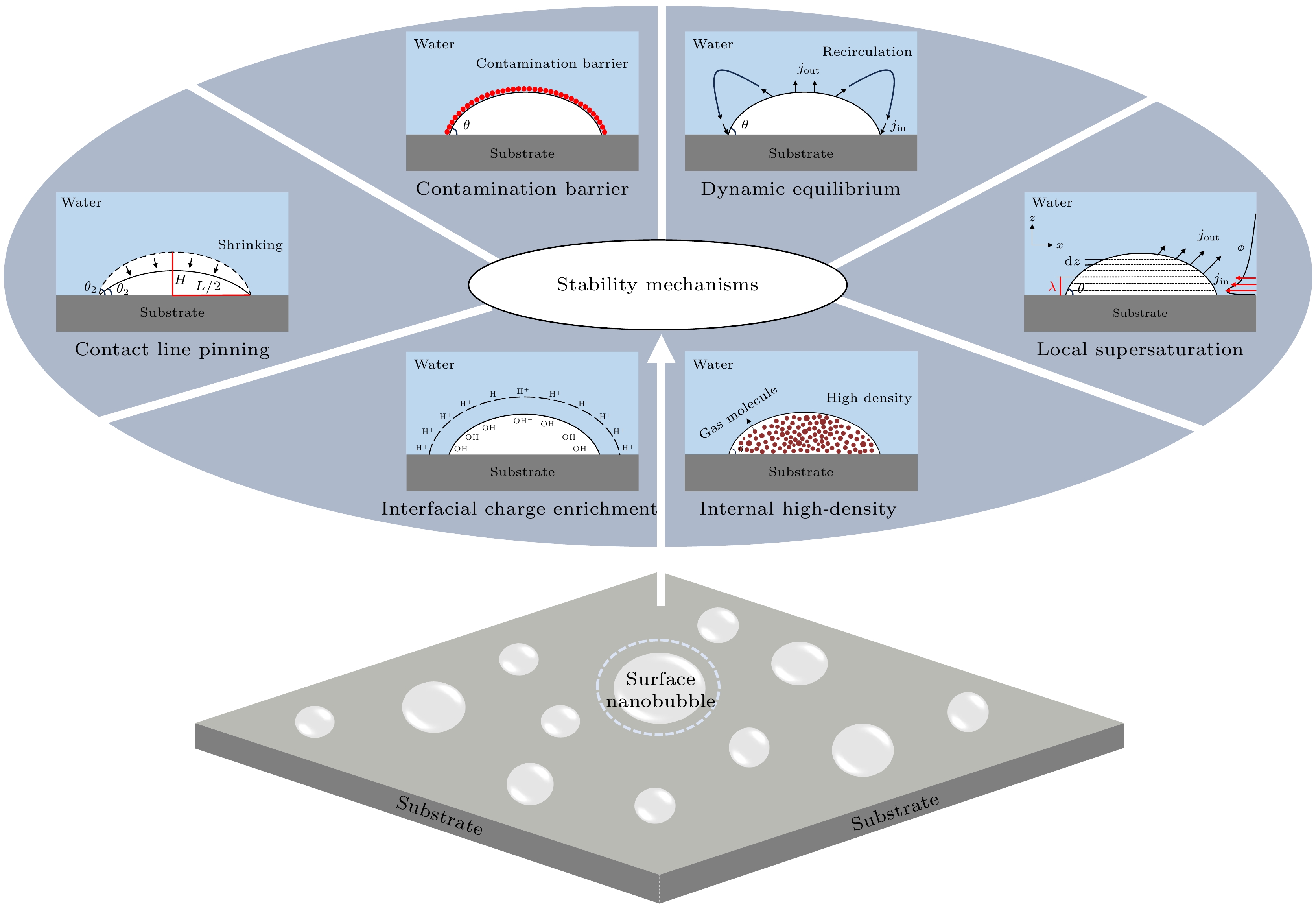
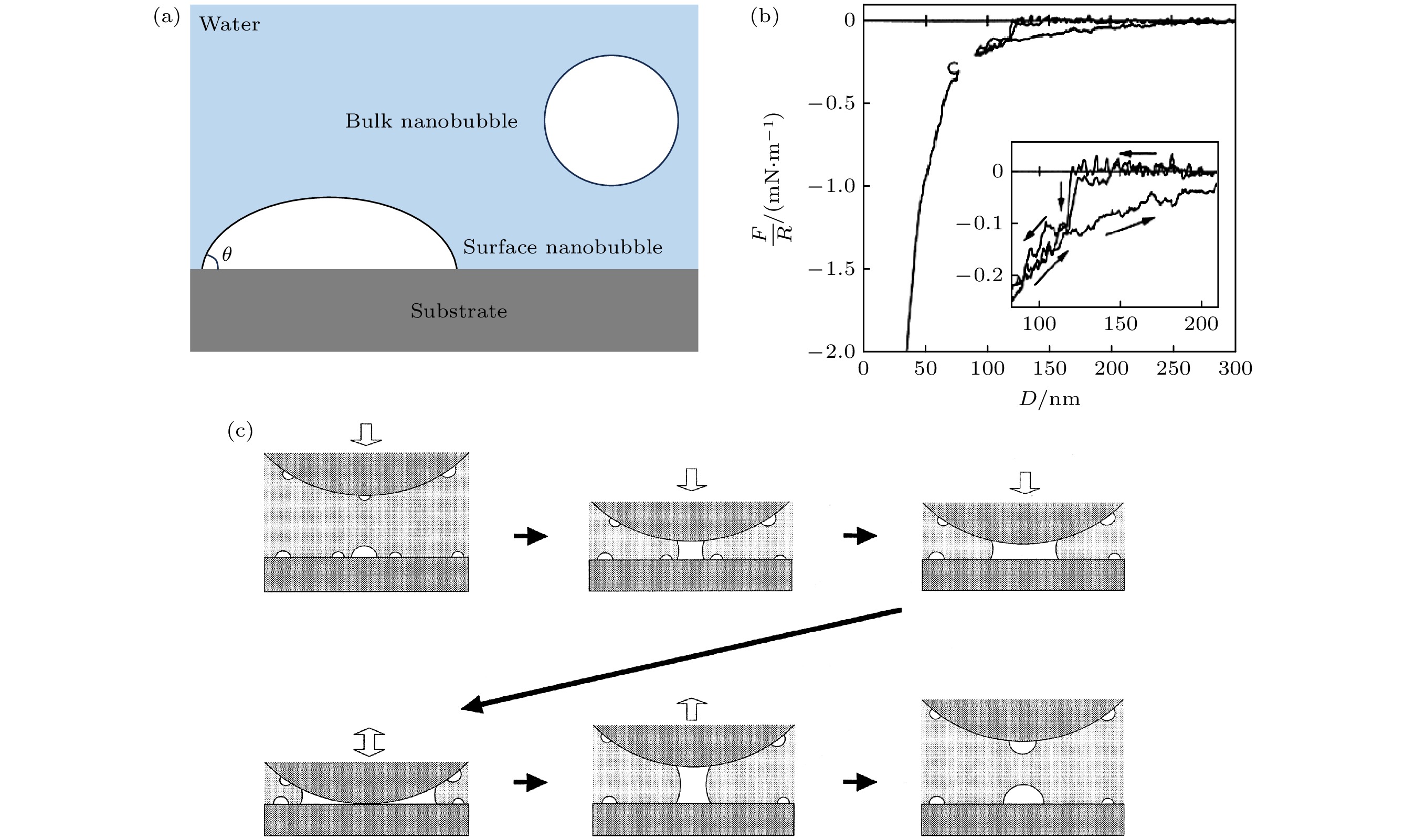
 下载:
下载:
